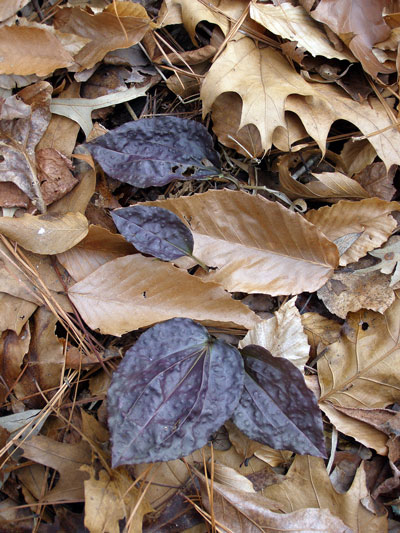Locate now for later viewing
By Ken Moore
Flora Columnist
Now is the best time of the year to locate two obscure native orchids that show their leaves in the winter. Of the two, cranefly orchid, Tipularia discolor, is the more common – and with a keen eye to the ground, you will spot it everywhere.
Its elusive close cousin, Aplectrum hyemale, puttyroot, is much less common, preferring a less acidic soil than is typical of most of our forests. You will have to keep a really keen eye focused to find the single leaf of puttyroot – and what a quiet thrill to finally spot one.
The leaves of these two orchids are busy now absorbing the winter sun and actively growing, manufacturing and storing essential nutrients and resources necessary for annual flowering and seed production. Though green now, these plants are not evergreen. They disappear in spring as the tree canopy shades the forest floor. They seem to be going into dormancy just when most plants are coming out of it, but they remain very active underground and send up a flowering stem in summer that is unnoticed by most woods walkers. The next winter season’s leaves will begin appearing in September as the forest canopy is beginning to drop its leaves again.
Spotting a single leaf or two of cranefly here and there – or sometimes an informal line or mat of up to a dozen individual leaves – is easy. The two-to-four-inch-long ovate or egg-shaped leaves are characteristically burgundy or purplish in color. Often the upper leaf surface may be green, but the lower surface is distinctively purplish.
The puttyroot leaf is larger, four to six inches, and elliptic shaped. Distinguished with white-streaked, plicate veins, the leaf surface looks like a miniature accordion spread open a little. The underside of the leaf is sometimes purplish.
The crushed corms of puttyroot produce a mucilaginous fluid that was sometimes used by pioneers to mend cracked pottery – but there are certainly not enough plants for such use today! Some folks call it Adam-and-Eve orchid, because the tuberous root is a pair of swollen corms leading to a somewhat romantic notion.
If you want to see either of these terrestrial orchids in flower, you will have to make note of their locations now, so you’ll know precisely where to look when you return in the summer to catch them. (Images of cranefly orchid flowers from past Flora stories can be viewed on The Citizen website.)
Mark several separate plants or populations, because these terrestrial orchids may flower several years in succession or they may sit out a year or two. Each summer’s discovery is a special treat, and every summer some of them are flowering somewhere.
I’ve been fortunate to spot lots of the cranefly orchids in flower during July and August, but I’ve never caught puttyroot in flower. Last summer, I went to my marked locations to discover I was a month late. Now I know to go searching earlier, during May and June.
Locally, I’ve seen puttyroots scattered in the alluvial forest of Triangle Land Conservancy’s Johnston Mill Nature Preserve and I’ve spotted them on some of the bluffs above the Eno River. If you explore different trails with a keen eye, you’ll eventually discover some.
Email Ken Moore at flora@carrborocitizen.com.
Read more Ken Moore Citizen columns at The Annotated Flora.




Comments are closed.